Orthodox Christmas in Lalibela
 Lalibela is Ethiopia’s answer to Jerusalem. In fact, it is often referred to as “The New Jerusalem” and it even has its’ own “Golgotha.” The legendary town is known for its’ incredible rock hewn churches. It is a place of elaborately dressed deacons and priests and a center for thousands of pilgrims who come during special occasions to recharge their “spiritual batteries.” Lalibela was one of the main reasons that I wanted to come to Ethiopia so badly. Thankfully, I wasn’t disappointed.
Lalibela is Ethiopia’s answer to Jerusalem. In fact, it is often referred to as “The New Jerusalem” and it even has its’ own “Golgotha.” The legendary town is known for its’ incredible rock hewn churches. It is a place of elaborately dressed deacons and priests and a center for thousands of pilgrims who come during special occasions to recharge their “spiritual batteries.” Lalibela was one of the main reasons that I wanted to come to Ethiopia so badly. Thankfully, I wasn’t disappointed.
I won’t go into lengthy descriptions of the place, rather I’ll get right to the selection of photos I’ve come up with and will try to tell the story through them. What I will say is that the ride into Lalibela was spectacular and as the sealed road ended, the feeling of going back in time quickly started to take over. It surprises me that places like Lalibela and its’ surroundings still exist parallel to the world that most of us in the “West” live in. It goes without saying that I am more than thankful this is still the case.
 One of the first things that struck me when I arrived at the first church (there are eleven) were the priests, deacons and the pilgrims, lining up or leaning against the walls and reading passages from the bible.
One of the first things that struck me when I arrived at the first church (there are eleven) were the priests, deacons and the pilgrims, lining up or leaning against the walls and reading passages from the bible.
 One could probably spend weeks just photographing all the characters that gather around the church to read the sacred texts in an almost trance-like state. I quite enjoyed photographing these folks and most of them didn't seem to mind me much either.
One could probably spend weeks just photographing all the characters that gather around the church to read the sacred texts in an almost trance-like state. I quite enjoyed photographing these folks and most of them didn't seem to mind me much either.
The careless actions of tourists, such as giving out of money for photos has made for a rather annoying experience when some of the devotees beg for money after being photographed. Money in exchange for photography is a complex topic, which doesn't necessarily have a right or wrong answer.
However, my opinion on the issue is firm and clear - I never give money for photos. Most of my work, particularly recently is documentary and I am not asking the subject to do anything they wouldn't normally do. I certainly wasn't asking the folks in these images to pose one way or another. A polite "no" and a smile was usually enough to make people understand my position. It seems that a few simply wanted to try their luck and weren't persistent in their requests. Nagging children are another matter, but that's a different topic altogether.
 The first day I started shooting was January 4th. By next day, the crowds started to increase noticeably. People from all over the North of Ethiopia came to celebrate in Lalibela, the holiest of places.
The first day I started shooting was January 4th. By next day, the crowds started to increase noticeably. People from all over the North of Ethiopia came to celebrate in Lalibela, the holiest of places.
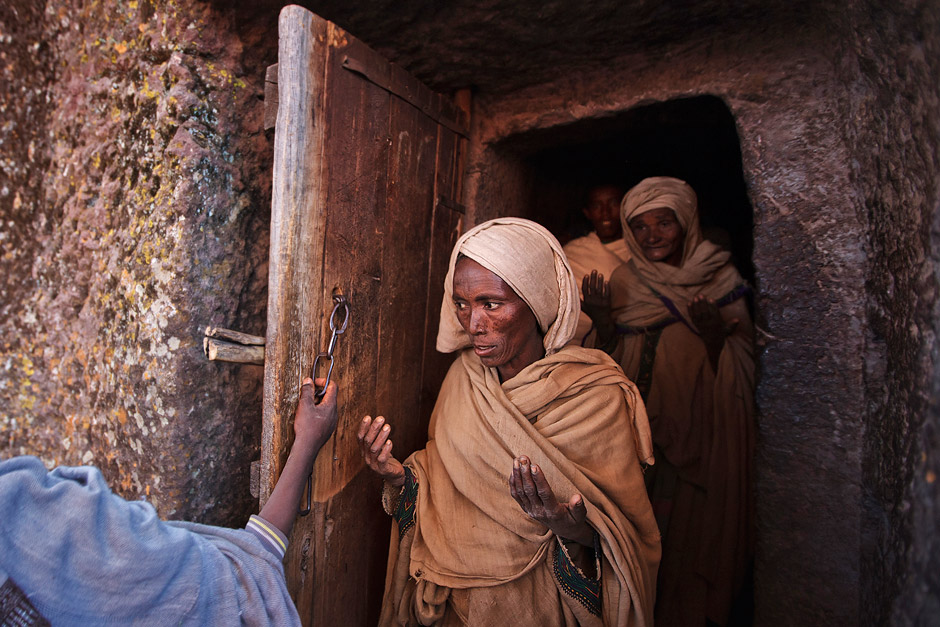 Many of the pilgrims would enter churches with their arms stretched out and their palms facing the sky. I had previously only seen this amongst Muslims. This was just one of the small details. Pilgrims also kissed doorways and walls upon entering the church compounds, as well as bowed down in front of the sacred buildings.
Many of the pilgrims would enter churches with their arms stretched out and their palms facing the sky. I had previously only seen this amongst Muslims. This was just one of the small details. Pilgrims also kissed doorways and walls upon entering the church compounds, as well as bowed down in front of the sacred buildings.
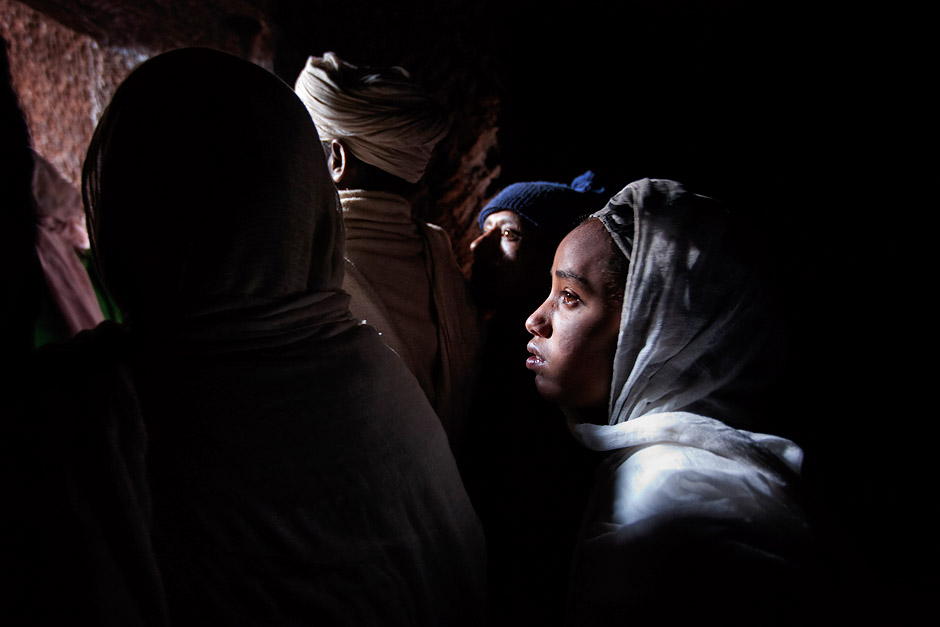 The church interiors provided for some truly fascinating lighting scenarios. Here a group of pilgrims is being illuminated by light at the end of a tunnel, while waiting to be let into the compound of one of the churches.
The church interiors provided for some truly fascinating lighting scenarios. Here a group of pilgrims is being illuminated by light at the end of a tunnel, while waiting to be let into the compound of one of the churches.
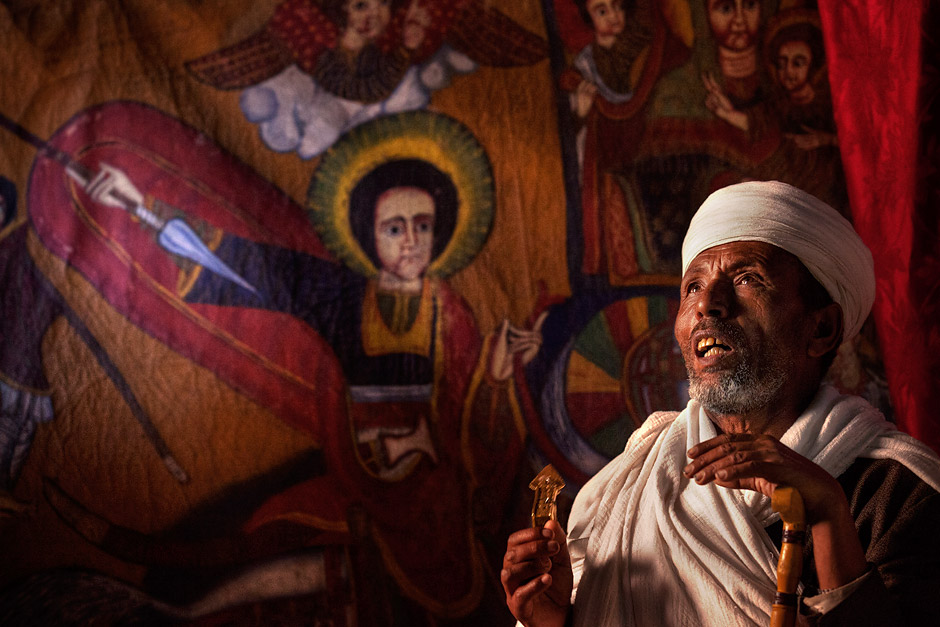 As Chrismas neared, the services were impossible to get into, due to the crowds. I did manage to get into a couple and here's the result of one of them.
As Chrismas neared, the services were impossible to get into, due to the crowds. I did manage to get into a couple and here's the result of one of them.
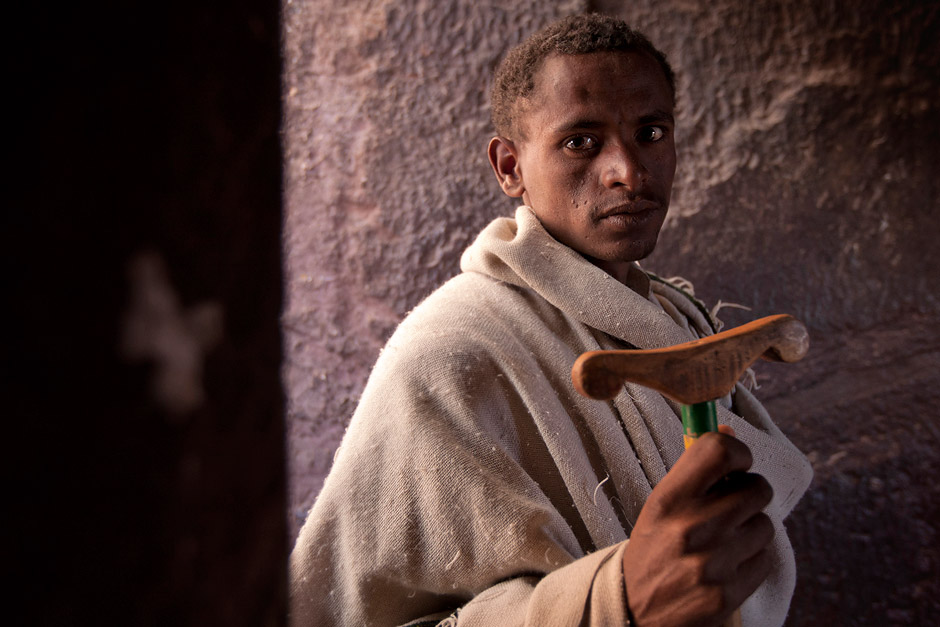 There were many indications that a lot of the pilgrims had never seen a photo of themselves. That was the reason that quite a large number asked me to photograph them, just to see their image at the back of the camera. When I think of it now, I wish I took those photos more seriously and placed the subjects into more ideal lighting situations against less busy backgrounds, as was (naturally) the case here.
There were many indications that a lot of the pilgrims had never seen a photo of themselves. That was the reason that quite a large number asked me to photograph them, just to see their image at the back of the camera. When I think of it now, I wish I took those photos more seriously and placed the subjects into more ideal lighting situations against less busy backgrounds, as was (naturally) the case here.
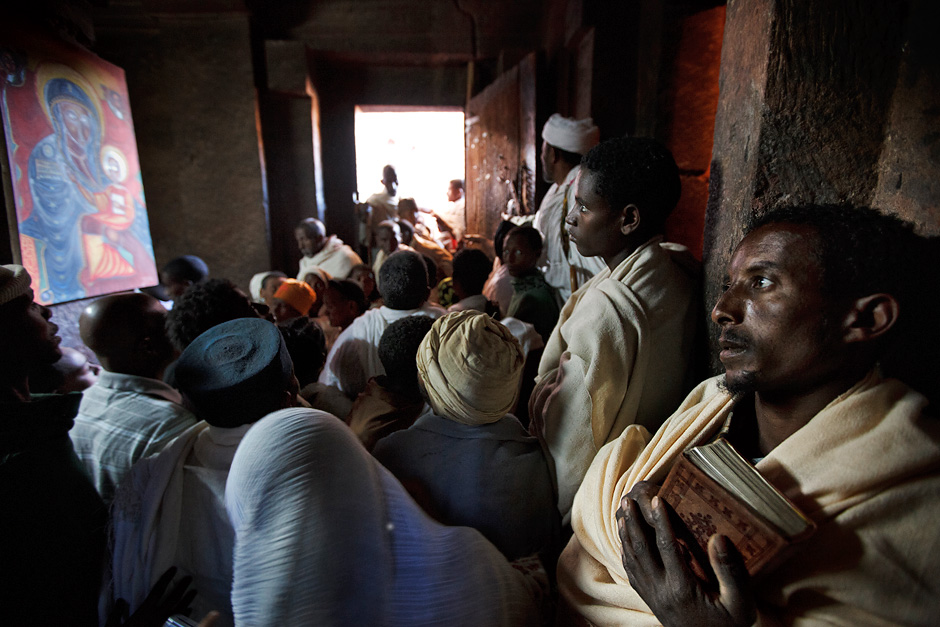 As the crowds grew, it became somewhat more difficult to shoot inside the churches due to lack of any room to operate. Here's where are wide angle lens came in handy.
As the crowds grew, it became somewhat more difficult to shoot inside the churches due to lack of any room to operate. Here's where are wide angle lens came in handy.
 A lot of the pilgrims would simply gaze at the churches in awe, which is more than understandable. I was in awe too and I've seen many buildings during my travels, I can only imagine how impressive the churches must be to those who haven't seen much more than mud huts and occasional ugly government buildings.
A lot of the pilgrims would simply gaze at the churches in awe, which is more than understandable. I was in awe too and I've seen many buildings during my travels, I can only imagine how impressive the churches must be to those who haven't seen much more than mud huts and occasional ugly government buildings.
 The pilgrims come from far and wide, from all over the North of Ethiopia. Some, like the man above come barefoot. Faith seems to be even stronger amongst those who have less. It was hard to get this shot, since it's not a common thing to photograph someone's feet. I also wanted the photo to represent a "real" moment, so I waited a couple of days near an ideal spot with the idea of getting an image of worn out feet.
The pilgrims come from far and wide, from all over the North of Ethiopia. Some, like the man above come barefoot. Faith seems to be even stronger amongst those who have less. It was hard to get this shot, since it's not a common thing to photograph someone's feet. I also wanted the photo to represent a "real" moment, so I waited a couple of days near an ideal spot with the idea of getting an image of worn out feet.
 A lot of people come with their own crosses. The reasons for pilgrimage vary. Some come to celebrate, some to mourn the death of a close one.
A lot of people come with their own crosses. The reasons for pilgrimage vary. Some come to celebrate, some to mourn the death of a close one.
 A lot of the pilgrims are overwhelmingly happy. Many groups dance and sing at virtually every church they reach.
A lot of the pilgrims are overwhelmingly happy. Many groups dance and sing at virtually every church they reach.
 Not unlike other religious places I've been to, things here ultimately seem to be about getting blessed (for the pilgrims) and collecting money (for the church). Here a priest waits to bless the next pilgrim just after he put his donation on the donation box.
Not unlike other religious places I've been to, things here ultimately seem to be about getting blessed (for the pilgrims) and collecting money (for the church). Here a priest waits to bless the next pilgrim just after he put his donation on the donation box.
 When I was a child, I was Christened in a Russian Orthodox Church, which has many similarities to the Ethiopian one. Kissing of the cross is a familiar sight and there was certainly a lot of cross kissing in Lalibela.
When I was a child, I was Christened in a Russian Orthodox Church, which has many similarities to the Ethiopian one. Kissing of the cross is a familiar sight and there was certainly a lot of cross kissing in Lalibela.
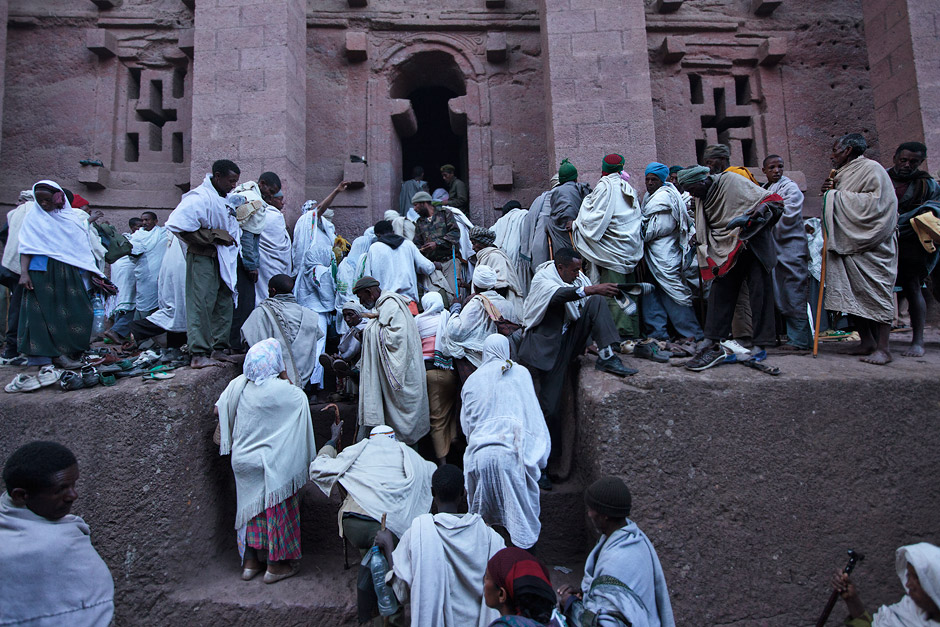 On the day of the celebration things really started to get intense. More and more people started to pour into the church from every imaginable entrance. The security had a tough job controlling the whole thing, but were surprisingly effective.
On the day of the celebration things really started to get intense. More and more people started to pour into the church from every imaginable entrance. The security had a tough job controlling the whole thing, but were surprisingly effective.
Going from church to church really becomes an effort. Thankfully crowds also mean lots of faces and lots of photographic opportunities.
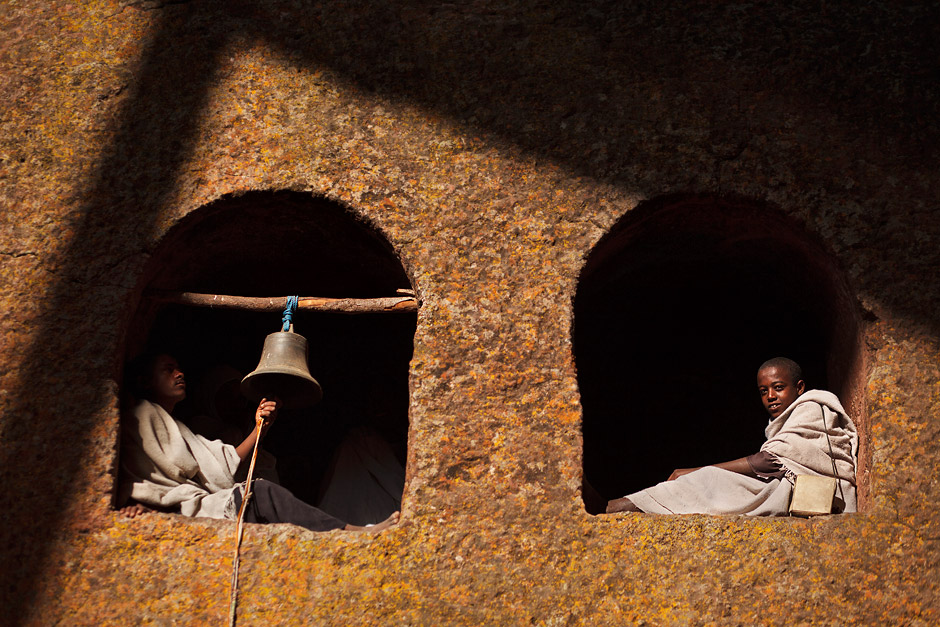 There are quieter moments amidst the madness also. I noticed a child around the top of the church, near the window with the bell. He noticed me too and gladly cooperated with my photographic idea (I told him to move forward a little). Soon another person came and I had the image I wanted.
There are quieter moments amidst the madness also. I noticed a child around the top of the church, near the window with the bell. He noticed me too and gladly cooperated with my photographic idea (I told him to move forward a little). Soon another person came and I had the image I wanted.
 Another thing that soon becomes apparent in the churches of Lalibela is how much of a challenge it is to enter the churches. At times, the high stairs and dark tunnels seem like no less than an obstacle course. Things were even more difficult before. I've seen older images around the areas which now have wooden stairs. People used to have to climb ropes to get there.
Another thing that soon becomes apparent in the churches of Lalibela is how much of a challenge it is to enter the churches. At times, the high stairs and dark tunnels seem like no less than an obstacle course. Things were even more difficult before. I've seen older images around the areas which now have wooden stairs. People used to have to climb ropes to get there.
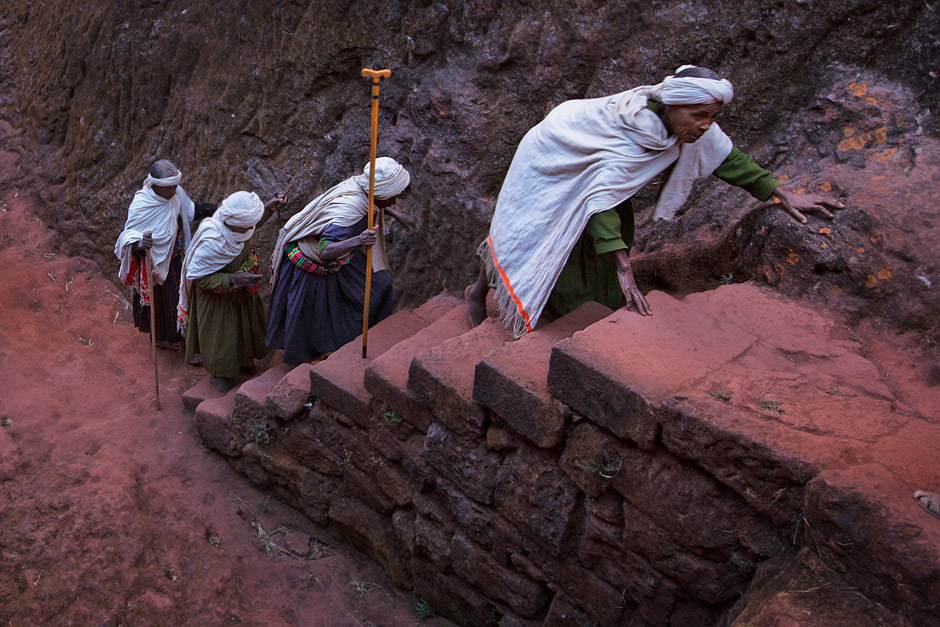 It never ceases to amaze me how faith drives the elderly folks to visit some of the most hard to reach pilgrimage sites. This is something I've seen almost everywhere that I've traveled.
It never ceases to amaze me how faith drives the elderly folks to visit some of the most hard to reach pilgrimage sites. This is something I've seen almost everywhere that I've traveled.
 As the sun begins to set it starts beaming through some of the interiors, adding a sense of divinity to the whole place.
As the sun begins to set it starts beaming through some of the interiors, adding a sense of divinity to the whole place.
 St George church, like some of the others was made from a single stone. It was the last of the churches in Lalibela that the king built and hence is considered to be the finest. It is the only church with a drainage system on the roof. My mandatory guide repeated a few times "You can appreciate how smart the king was to have built something like that so long ago."
St George church, like some of the others was made from a single stone. It was the last of the churches in Lalibela that the king built and hence is considered to be the finest. It is the only church with a drainage system on the roof. My mandatory guide repeated a few times "You can appreciate how smart the king was to have built something like that so long ago."
Pilgrims flocked to St George all day. Some prayed facing the church, others took rest while enjoying this architectural marvel.
 While in Lalibela I stayed most of my days at an acquaintance's place - a local house with no shower or toilet. It was a little rough, but nothing in comparison to the conditions the pilgrims lived. Most just slept outside, in the cold, under the open sky. The food was basic, mostly types of grains and beans.
While in Lalibela I stayed most of my days at an acquaintance's place - a local house with no shower or toilet. It was a little rough, but nothing in comparison to the conditions the pilgrims lived. Most just slept outside, in the cold, under the open sky. The food was basic, mostly types of grains and beans.
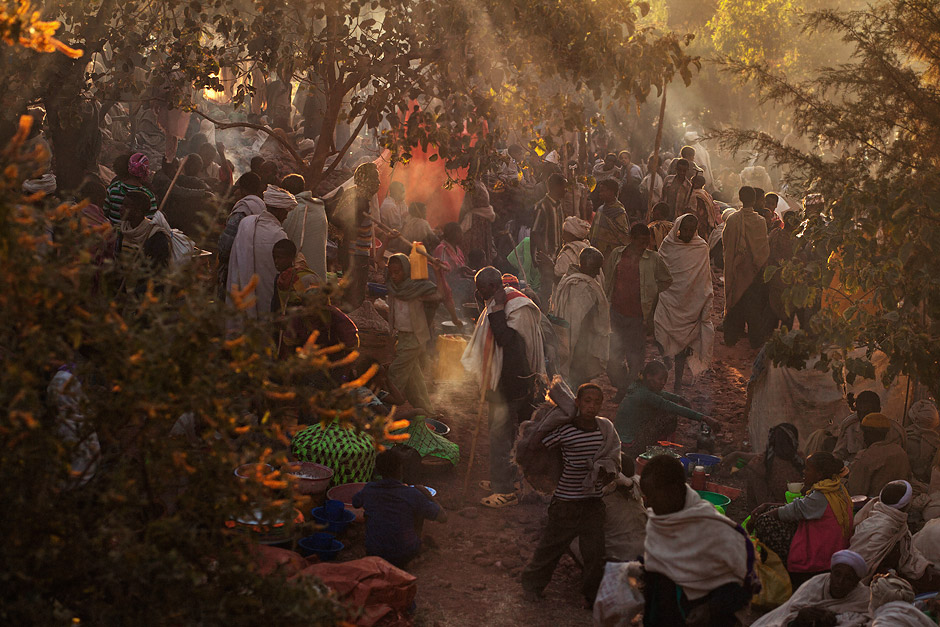 The pilgrims set up a temporary village outside of the churches in Lalibela. I am not sure of the numbers, but I am certain they were in the tens of thousands.
The pilgrims set up a temporary village outside of the churches in Lalibela. I am not sure of the numbers, but I am certain they were in the tens of thousands.
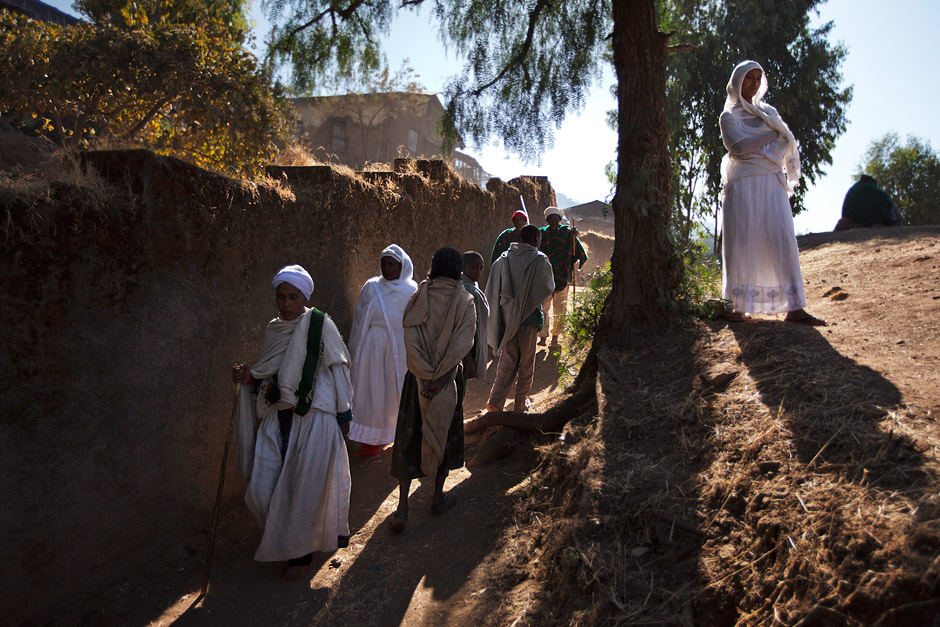 It's not only the churches, but the streets (if you can call them that) of Lalibela which provide great photo opportunities. With the constant flow of people one is never short of subjects. In the image above, I thought that the woman had a bit of a divine look to her (with the backlight) so I couldn't resist making a few frames.
It's not only the churches, but the streets (if you can call them that) of Lalibela which provide great photo opportunities. With the constant flow of people one is never short of subjects. In the image above, I thought that the woman had a bit of a divine look to her (with the backlight) so I couldn't resist making a few frames.
 One thing that really stands out in Lalibela, even during such busy time of the year as Christmas is the lack of motorized traffic. Donkeys, mules and horses seem to be the go, if not them, then people carry goods using their own muscle power.
One thing that really stands out in Lalibela, even during such busy time of the year as Christmas is the lack of motorized traffic. Donkeys, mules and horses seem to be the go, if not them, then people carry goods using their own muscle power.
 As the day of the final, big celebration approached, hundreds of pilgrims began making fuses for the candles, which were given out to everyone present at St Mary's church during the big evening.
As the day of the final, big celebration approached, hundreds of pilgrims began making fuses for the candles, which were given out to everyone present at St Mary's church during the big evening.
 I took a few photos at the Baptism pool at St. Mary's church. This was one wacky place. At first, I was told that infertile women came to take a dip in the holy water (very foul looking) so that they could conceive. Later I saw men coming here too and figured that perhaps they have the same issue. At one stage I saw a mentally ill boy thrown into the very same pool and figured that the water is believed to have powers to cure anything.
I took a few photos at the Baptism pool at St. Mary's church. This was one wacky place. At first, I was told that infertile women came to take a dip in the holy water (very foul looking) so that they could conceive. Later I saw men coming here too and figured that perhaps they have the same issue. At one stage I saw a mentally ill boy thrown into the very same pool and figured that the water is believed to have powers to cure anything.
The sight of people being dipped in the pool is disturbing or funny, depending how you look at it. It appears that most of the folks entering the pool had no idea how to swim, so they made the most awkward of faces and desperately gasped for air. The crowd cheered on, occasionally breaking into laughter, when someone would make a particularly "funny" face.
During the eve of the celebration my acquaintance helped me get about as close as one could be to the "action". The problem was that being so close didn't actually allow me to show the scope of the celebration. I took a few photos of the deacons chatting as things were getting ready and moved on.
 After some fairly monotonous chants the clergy would occasionally break into a more exciting rhythm, a priest would come out with candles in his hand, dramatic drumming and chanting ensued and continued as he walked around the church and blessed the devotees.
After some fairly monotonous chants the clergy would occasionally break into a more exciting rhythm, a priest would come out with candles in his hand, dramatic drumming and chanting ensued and continued as he walked around the church and blessed the devotees.
 The whole church compound was full. It was hard to move anywhere. I ended up getting a spot on a rather small column. It provided me with great views from above, but was not the best place to sit. It seemed that I could only fit half a but-cheek onto it, especially every time after I got up to take a shot, as my local neighbour would "steal" some of my space. Nevertheless, it is in this place that I saw that Ethiopians are very accommodating and quiete hospitable, since the "neighbour" actually gave up half of the space for me in the first place.
The whole church compound was full. It was hard to move anywhere. I ended up getting a spot on a rather small column. It provided me with great views from above, but was not the best place to sit. It seemed that I could only fit half a but-cheek onto it, especially every time after I got up to take a shot, as my local neighbour would "steal" some of my space. Nevertheless, it is in this place that I saw that Ethiopians are very accommodating and quiete hospitable, since the "neighbour" actually gave up half of the space for me in the first place.
 The big deal about the ceremony for me visually, besides the procession was the lighting of candles, which was meant to be done by everybody simultaneously. Some people began lighting them early. I thought that was that, photographed it and went to sleep after a very exhausting evening. I was told later that the mass lighting of candles only happened around two hours after I left.
The big deal about the ceremony for me visually, besides the procession was the lighting of candles, which was meant to be done by everybody simultaneously. Some people began lighting them early. I thought that was that, photographed it and went to sleep after a very exhausting evening. I was told later that the mass lighting of candles only happened around two hours after I left.
 Even though I wasn't there when everyone lit their candles their was still enough people doing so to make things visually interesting. People lit candles outside the church as well as everywhere in the vicinity.
Even though I wasn't there when everyone lit their candles their was still enough people doing so to make things visually interesting. People lit candles outside the church as well as everywhere in the vicinity.
 The reason I wanted to go to sleep was so that I could have enough energy to photograph the events the next morning. Another procession was to take place. The clergy lined up along the top of the walls of the church compound, performed a ritual dance and showed the devotees some sacred icons.
The reason I wanted to go to sleep was so that I could have enough energy to photograph the events the next morning. Another procession was to take place. The clergy lined up along the top of the walls of the church compound, performed a ritual dance and showed the devotees some sacred icons.
 As you can see from the image above, the crowds got rather insane by this stage. Again, I must note how accommodating the Ethiopians are towards foreigners. I managed to again get one of the best spots despite having left in the middle of the night
As you can see from the image above, the crowds got rather insane by this stage. Again, I must note how accommodating the Ethiopians are towards foreigners. I managed to again get one of the best spots despite having left in the middle of the night
 The deacons waited atop the wall for the procession to continue and that provided me with some chances to make photographs.
The deacons waited atop the wall for the procession to continue and that provided me with some chances to make photographs.
 A mad rush begins as the ceremony ends. I am really quite surprised that there were no casualties during the celebration. I guess it's a combination of people being civil enough and the security knowing what they were doing.
A mad rush begins as the ceremony ends. I am really quite surprised that there were no casualties during the celebration. I guess it's a combination of people being civil enough and the security knowing what they were doing.
 The next morning the crowds are gone and only a few worshippers pray around St George church. It was amazing how everyone disappeared so quickly.
The next morning the crowds are gone and only a few worshippers pray around St George church. It was amazing how everyone disappeared so quickly.
I realize that this has turned into one long, photo-filled blog post. I guess that kinda makes up for my lack of blogging over the past few months.
I am now in a place called Bahir Dar, in a hotel by lake Tanna, the biggest lake in Ethiopia. I plan to visit some of the lake monasteries that this region is famous for and might discover something else along the way.
That's (finally) all for this post. No idea when the next one will be.



